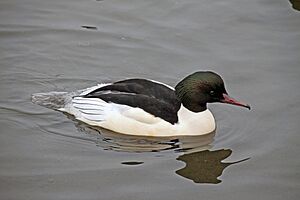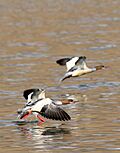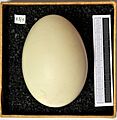Common merganser facts for kids
Quick facts for kids Common merganser |
|
|---|---|
 |
|
| M. m. merganser, male in Sandwell, England | |
 |
|
| M. m. americanus, female | |
| Conservation status | |
| Scientific classification | |
| Genus: |
Mergus
|
| Species: |
merganser
|
| Subspecies | |
|
3, see text |
|
 |
|
| M. merganser range Breeding Resident Passage Non-breeding | |
| Synonyms | |
|
Merganser americanus Cassin, 1852 |
|
The common merganser is a large duck found in rivers and lakes across Europe, Asia, and North America. In North America, it's called the common merganser, but in Europe and Asia, people often call it the goosander. These ducks mainly eat fish and build their nests in tree holes.
Contents
Understanding Common Merganser Names
The common merganser's scientific name is Mergus merganser. This name was first given by a Swedish scientist named Carl Linnaeus in 1758. He was famous for creating the system we use today to name living things.
The name Mergus is an old Latin word for a waterbird. Merganser comes from mergus and anser, which means "goose" in Latin. So, its name basically means "diving goose-like bird."
Types of Common Mergansers
There are three slightly different types, or subspecies, of the common merganser:
| Image | Subspecies | Where They Live |
|---|---|---|
| M. m. merganser | Found across northern Europe and northern Asia. | |
| M. m. orientalis | Lives in the mountains of Central Asia. This type is a bit bigger and has a thinner beak. | |
| M. m. americanus | Found in North America. Males of this type have a black bar on their white inner wing, which you can see when they fly. |
What Common Mergansers Look Like
Common mergansers are fairly large ducks. They are about 58 to 72 centimeters (23 to 28 inches) long. Their wings can spread out 78 to 97 centimeters (31 to 38 inches) wide. They weigh between 0.9 and 2.1 kilograms (2 to 4.6 pounds). Males are usually a bit larger than females.
Like other ducks in their group, they have longer feathers on their head. These feathers usually lie flat, making their head look smoothly rounded.
Male and Female Differences
- Adult males (during breeding season): They have a white body that can look slightly pink. Their head is black with a shiny green color. Their back and tail are grey, and their wings are mostly white on the inside and black on the outside.
- Females and males (after breeding, from July to October): They are mostly grey. Their head is reddish-brown, and they have a white patch under their chin. The inner part of their wings is white.
- Young mergansers: They look similar to adult females. They also have a short white stripe with a black edge between their eye and beak.
Their beak and legs are red or brownish-red. These colors are brightest on adult males and dullest on young birds.
How Common Mergansers Behave
Common mergansers are very good at catching fish. They have special beaks that help them.
What They Eat
These ducks are known as "sawbills" because their beaks have jagged edges. These edges help them grip slippery fish. Besides fish, they also eat:
- Shellfish like snails
- Crabs and other crustaceans
- Worms
- Insect larvae
- Frogs and other amphibians
Sometimes, they might even catch small mammals or birds. The pink color you sometimes see on male mergansers comes from pigments in the crustaceans and fish they eat.
When they are not diving for food, you can often see them swimming on the water. They also rest on rocks in the middle of rivers or hide in plants along the riverbank. In winter, they might rest on the edge of floating ice.
Daily Habits
Common mergansers can live in both fresh water, like rivers, and salt water, like estuaries. In large rivers, they often float downstream for a few miles. Then, they either fly back or swim back, diving for fish the whole way.
In smaller streams, they usually stay in pairs or small groups. They float along, spinning in the fast-moving water, or actively fish in deep pools. They can float easily like other ducks. But they can also swim deep in the water, similar to cormorants, especially when swimming against the current.
They often sit on rocks in the water, like cormorants. Sometimes, they spread their wings partly open to warm up in the sun. To take off from the water, they have to flap their wings along the surface for several yards. Once in the air, they fly strongly and fast.
Sometimes, a group of mergansers will work together to catch fish. They form a semicircle and drive the fish into shallow water, where it's easier to catch them. Their usual call is a low, rough croak. But during breeding season, males and young birds make a soft, sad whistle.
These ducks are generally careful. One or more birds will often act as a lookout to warn the group if danger is near. If they are disturbed, they sometimes spit out food before moving away. On land, they walk awkwardly. But if they need to run, they stand very upright, like penguins, though they often stumble.
Raising Their Young
Common mergansers usually build their nests inside tree holes. This means they need old forests to live and raise their families. They will also use large nest boxes if people provide them. These boxes need an entrance hole about 15 centimeters (6 inches) wide.
In places without many trees, like some Central Asian mountains, they use holes in cliffs or steep riverbanks. These nests can sometimes be far from the water. The female lays 6 to 17 eggs, but usually 8 to 12. The eggs are white or yellowish. They only raise one group of young each year.
Right after hatching, the mother takes her ducklings to rivers or lakes on her back. The young birds eat small water insects and tiny fish. They learn to fly when they are 60 to 70 days old. Young mergansers can have their own babies when they are two years old.
Sometimes, female mergansers will gather many ducklings together. This is called a "crèche." One female has been seen with over 70 ducklings at once!
Where They Travel
Common mergansers are partial migrants. This means some birds move to warmer places for winter, while others stay put. They move away from areas where rivers and large lakes freeze over. But if the water stays open, they will stay there all year.
Birds from eastern North America fly south in small groups to the United States. They look for lakes and rivers that don't freeze. On the milder Pacific coast, they live there all year round. Birds from Scandinavia and Russia also fly south for winter. However, most birds in western Europe and some in Japan stay in their home areas.
In some groups, the males also travel to different areas just to shed their old feathers. They leave their breeding areas as soon as the young hatch, usually from June to September. For example, most male mergansers from western Europe fly north to estuaries in northern Norway to molt. They leave the females to take care of the ducklings. Smaller groups of males also use estuaries in eastern Scotland for molting.
Common Merganser Status and Protection
Overall, the common merganser is not considered an endangered species. However, in some areas, people who fish illegally sometimes harm them. In February 2020, a rare common merganser was seen in Central Park, New York. The bird was in trouble because its beak was stuck in some trash.
In western Europe, the number of breeding mergansers has grown and spread south since about 1850. They started breeding in Scotland in 1871 and in England in 1941. Their population has also increased a lot in the Alps mountains. They are very rare in Ireland, with only a few pairs breeding regularly in County Wicklow.
The goosander is one of the species protected by the Agreement on the Conservation of African-Eurasian Migratory Waterbirds. This agreement helps protect birds that migrate across Africa and Eurasia.
Images for kids












